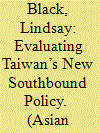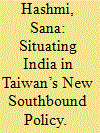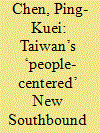|
|
|
Sort Order |
|
|
|
Items / Page
|
|
|
|
|
|
|
| Srl | Item |
| 1 |
ID:
192220


|
|
|
|
|
| Summary/Abstract |
This paper examines Taiwan’s New Southbound Policy (NSP-T) from a soft power conceptual perspective. It traces the origins of the NSP-T before the Tsai Ing-wen administration came into power in 2016 and then discusses the NSP-T’s subsequent implementation. Through an overview of the earlier ‘Go South Policy’ (GSP) during the administrations of Lee Teng-hui, Chen Shui-bian and Ma Ying-jeou (1994–2016), this paper finds that soft power was not institutionalised in the policy despite it being a prevalent concept, and repeatedly propagated by successive Taiwanese presidents for their foreign policy goals. Soft power is now outlined as the ‘overarching link’ connecting Taiwan and the NSP-T countries for the attainment of the former’s three strategic aims ─ identifying a new direction and driving force for a new stage of Taiwan’s economic development, redefining Taiwan’s important role in regional development and creating future value for Taiwan’s engagements in the region. This article seeks to extrapolate how soft power contributes to the achievement of the three policy visions in Southeast Asia. Through assessments of NSP-T cooperation programmes and strategies in its six sectors of medical care, agriculture, manufacturing, tourism, education and civil society, an analytical model is introduced to explain Taiwan’s soft power projection in Southeast Asia.
|
|
|
|
|
|
|
|
|
|
|
|
|
|
|
|
| 2 |
ID:
164966


|
|
|
|
|
| Summary/Abstract |
Critiques of Taiwanese President Tsai Ing-wen’s New Southbound Policy overemphasize Beijing’s ability to hinder what is essentially a rational economic move that was already underway prior to Tsai’s inauguration. China’s antagonistic stance toward the New Southbound Policy merely pushes Taiwan into the hands of Japan, China’s regional rival.
|
|
|
|
|
|
|
|
|
|
|
|
|
|
|
|
| 3 |
ID:
192226


|
|
|
|
|
| Summary/Abstract |
This article compares the ways Taiwan and South Korea have navigated the politics of soft power to gradually exert their influence in South and Southeast Asia. It then analyses Taiwan's self-declared ‘warm power' practices. The article is divided into five parts. The first highlights the conceptual evolution of soft power and new policy practices in Asia. The second discusses the transformation and strengthening from soft power to warm power. The third introduces South Korea's New Southern Policy through the lens of soft power. The fourth presents Taiwan’s New Southbound Policy, and the conclusion compares the impact and prospects of the two.
|
|
|
|
|
|
|
|
|
|
|
|
|
|
|
|
| 4 |
ID:
192224


|
|
|
|
|
| Summary/Abstract |
The widening rift between the United States and China, the former’s efforts to strengthen ties with partners in Asia, China’s aggressive postures and its poaching of Taiwan’s remaining diplomatic allies have opened up new possibilities for Taiwan’s external engagement. The inclination of the Democratic Progressive Party-led government in Taiwan to forge regional partnerships led it to develop its flagship foreign policy – the New Southbound Policy (NSP-T) and to proactively look towards India. Amid the changing geopolitical situation, the regional positions and roles of India and Taiwan have undergone a transformation and the two states’ interests in advancing relations have become visible. While NSP-T represents a concrete decision from Taiwan’s side to push outwards, the deterioration in India’s relations with China, particularly since the border clashes at Galwan in 2020, along with India’s own growing role in the region, could be categorised as pull factors. This article offers an Indian perspective on India’s place in the NSP-T. It argues that China’s increasing assertiveness and the possibility of mutual economic benefits are the main factors driving Taiwan-India relations and that the NSP-T is facilitating the cooperation and advancement in the ties.
|
|
|
|
|
|
|
|
|
|
|
|
|
|
|
|
| 5 |
ID:
174737


|
|
|
|
|
| Summary/Abstract |
Taiwan’s relations with South and Southeast Asia have become the focus of scholarly discussion since it proposed the New Southbound Policy (NSP) in 2016. Few touch on the NSP’s effect on Taiwan’s relations with countries outside the NSP targets. This paper argues that the NSP has a positive effect on US–Taiwan relations. The people-centered approach of the NSP helps the Taiwanese government create a credible commitment to a moderate foreign policy. It signals Taiwan’s resolve to uphold the US interests in Taiwan Strait. Taiwan’s policy direction has received the US’s approval, resulting in cordial US–Taiwan relations. The public supports from the US have strengthened Taiwan’s confidence under tense cross-Strait relations. Recently, the US’s Indo-Pacific strategy provides Taiwan an opportunity to establish a closer tie with the US. But the prospect of bilateral cooperation in the Indo-Pacific region depends on a clear proposal.
|
|
|
|
|
|
|
|
|
|
|
|
|
|
|
|
| 6 |
ID:
192222


|
|
|
|
|
| Summary/Abstract |
Launched by President Tsai Ing-wen in 2016, the New Southbound Policy (NSP-T) aims to enhance cooperation and exchange between Taiwan and 18 countries in Southeast Asia, South Asia and Australasia. The policy is a concerted effort designed to expand Taiwan’s presence across these broad regions by leveraging Taiwan’s cultural, educational, technological and economic resources. There is no doubt that the NSP-T has yielded results in terms of economic cooperation and people-to-people exchanges between Taipei and Southeast Asia. However, with Beijing pushing forward its own agenda and, at the same time, asserting more pressure on Taiwan, there are questions about how Taiwan should respond. This article argues that China, through its enormous economic influence and constant consolidation of ‘One China Policy’ in Southeast Asia has limited the success and effectiveness of the NSP-T in the region. The impact of this ‘China Factor’ has, however, differed among Southeast Asian countries due to their distinct relationships with China. This article also argues that while China’s economic diplomacy has earned Beijing considerable influence in the region, that influence has not been translated into Southeast Asian support for its foreign policies, principles nor values – leaving Taiwan with rooms to maneuver its strategic space in the region. Therefore, several policy directions, clusters and implementations have been identified for Taiwan’s consideration in order to enhance existing Taiwan-ASEAN relations. These are: the visible and viable institutionalisation of the NSP-T; addressing existing and emerging issues in the NSP-T; and the consolidation of Taiwan-ASEAN long term connectivity.
|
|
|
|
|
|
|
|
|
|
|
|
|
|
|
|
| 7 |
ID:
160702


|
|
|
|
|
| Summary/Abstract |
Over the past three decades, Taiwan has been struggling to gain an advantage and develop its role in Asia. This island has strived to balance its asymmetric relationship with China by engaging in regional integration in Southeast Asia and beyond. In the 1990s, the Taiwan government initiated the first wave of its Go South Policy aimed at building links at business and government levels with that region. The institutional and social legacy of the Go South Policy contributed to the making of the New Southbound Policy (NSP) which was proposed toward the end of 2015. This paper will unpack Taiwan’s presence in Southeast Asia by highlighting the international socialization process of the NSP and Taiwan’s strategic interaction with the region. It consists of four sections: the first section introduces the concept of international socialization. The second section discusses the positioning of Taiwan’s previous Go South policies. Starting with the shift from a mentality of “Taiwanese Asia” (Taiwan de yazhou, 臺灣的亞洲) to one of “Asian Taiwan” (Yazhou de Taiwan, 亞洲的臺灣), it describes in detail how Taiwan’s successive southward engagement initiatives have blended into the international socialization processes in the region. The third section highlights the relationships the policy’s key actors and stakeholders, including transnational actors, are establishing with their counterparts in Southeast Asia and the new social linkages that are currently being promoted. This includes the activities of Taiwanese residents in Southeast Asia and Southeast Asian migrants in Taiwan. The paper concludes by summarizing Taiwan’s international socialization in Asia.
|
|
|
|
|
|
|
|
|
|
|
|
|
|
|
|
|
|
|
|
|